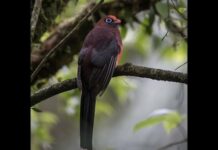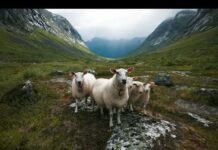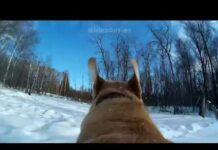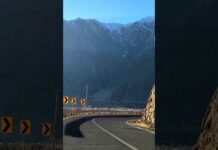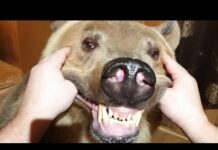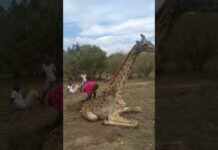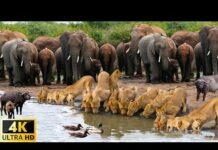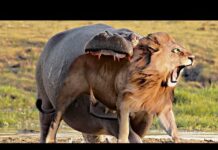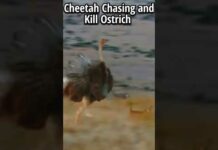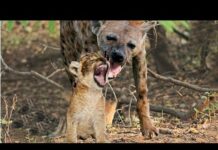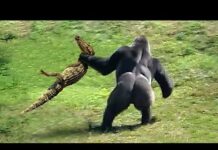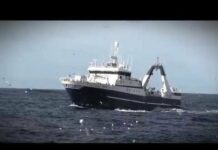Blue Realm – Episode 2: Lions of the Deep | Wildlife Documentary
Since the 1970’s, sea lion populations have declined more than 80% along the North Pacific coast. Scientists at the University of British Columbia and the Vancouver Aquarium are working together to help save Canada’s iconic and largest pinniped – the stellar sea lion
To help understand why their numbers are dropping, researchers work with the highly intelligent mammals at a unique floating laboratory. At The Open Water Research Station, free swimming seals and sea lions are observed in their natural habitat. In Alaska, wild stellar sea lions seem to be thriving, but prove to be an aggressive and difficult animal to study and photograph. At the research station, these tame, remarkable animals are providing fresh insights into the fragile ocean food chain of the North Pacific.
▬▬▬▬▬▬▬▬▬
Subscribe Free Documentary – Nature Channel for free: http://bit.ly/2mFDC3Q
Facebook: https://bit.ly/2QfRxbG
Twitter: https://bit.ly/2QlwRiI
▬▬▬▬▬▬▬▬▬
#FreeDocumentaryNature #Documentary #BlueRealm
▬▬▬▬▬▬▬▬▬
Free Documentary is dedicated to bring high-class documentaries to you on youtube for free. With the latest camera equipment used by well-known filmmakers working for famous production studios. You will see fascinating shots from the deep seas and up in the air, capturing great stories and pictures from everything our beautiful and interesting planet has to offer.
Enjoy stories about nature, wildlife, culture, people, history and more to come.
Seals sea lions and walruses are pinnipeds a family whose latin name means wing or fin-footed carnivorous marine mammals they spend much of their lives at sea but rest mate and rear their young on land surprisingly their closest relatives are.
Bears 33 diverse species of pinniped scratch out a living in some of earth's most hostile environments and there's no shortage of predators with a taste for seal meat around the globe many pinniped populations are growing while others are crashing.
These wild fluctuations in numbers remain a mystery at the open ocean research center specially trained sea lions help scientists investigate the animal's energy requirements and diving physiology in vancouver's marine mammal rescue center abandoned and injured harbor.
Seals are nursed back to health and released into the wild at the university of british columbia researchers study many facets of pinniped biology you can learn a lot about animals from what they eat and what they excrete remarkably intelligent and easily.
Trained seals and sea lions are popular attractions at marine parks and aquariums and like pinnipeds in the wild these guys certainly love a big meal.
So on canada's west coast a dedicated team of professionals worked together to learn more about an intriguing group of animals finnipeds more commonly known as seals.
And sea lions veterinarians scientists biologists and students from the vancouver aquarium and university of british columbia are trying to answer several puzzling questions surrounding pinnipeds they also hope to unlock two great marine mysteries.
why are stellar sea lions thriving in canadian waters while in northern alaska and russia their numbers are falling at an unprecedented rate and why are northern fur seal populations crashing in the bering sea at the ubc open water research station.
Highly trained sea lions provide researchers with new insights into piniped behavior and biology fresh seafood is the animal's prime motivator and a key training tool gaining their trust and cooperation is challenging work you're all sick they just need a little.
Incentive dollar seasons in the wild needles quite a bit when the herring comes in to lay eggs and stuff there's a lot of it around they'll definitely eat as much as they can herring is a very high fat fish so it's very calorically dense it's got a lot of energy keeps animals at a good healthy.
Weight so right now these animals are eating between five and eight kilograms of herring a day we supplement the herring with the vitamins in order to replace the nutrients that get lost in the freezing process unlike dogs that are trained with food.
And praise sea lions are all about the treats oceans are very food motivated animals so we use herring as their primary reinforcer to get them to do the research that we need them to do if you walk out there and actually do something without a bucket of fish they give you a.
Look that says uh where's my fish and they won't actually do anything but when they see the fish they're ready to go and they'll do anything we ask them it's first thing in the morning and the sea lions have a heavy day of in-water training nothing gets their attention like a bucket of fresh herring.
And sikkas here has got a really cool vocalization sikka let's put uh let's put your harness on because we can attach all sorts of different equipment to the harness and that way we can find out what's going on with the animals how much energy they use how they swim.
All sorts of cool information this uh device here is called a vhf tag and this transmits a radio signal so we know where sika is and we can track her wherever she goes so these are a couple other cool pieces of research equipment that we use this is called an accelerometer and it tells us how she swims.
This device here is called a time depth recorder so this tells how deep she swims uh it will actually give us water temperature we have a camera here that we can mount onto the harness of the sea lions and that way the animals can actually take their own their own video footage and we can see really what the animals are.
Doing when they're out in the wild and we can't see them she's really a wild animal and sitka has all of those wild tendencies we work very closely with these guys to be able to have them used to us and used to other people around but it takes a lot of time and patience to get to that point.
Good girl the first training exercises of the day are swim tests the animals are always eager to venture into the open sea ready for a swim okay let's go in the water oh it's thicker right here so when i have sika swimming along the.
Boat here like this when i put my hand down it means for her to go dive underwater and swim next to the boat and she'll stay down there for uh a short period of time about 30 seconds even up to a minute sometimes and then if i raise my hand up it means for her to surface and that.
Means i'm going to give her reinforcement that's what we call a bridge and a bridge tells the animals when they've done the behavior that we've looked for the seals and sea lions have got different ways to swim the seals use their hind flippers they rely on a lot of blubber to stay warm.
Whereas the sea lions and fur seals are used in the front clippers turns out to be not the most efficient way to swim what we've learned here is that they're not great divers we're really surprised to realize just that the average dive time is only about three minutes max and that turns out to be an efficient.
Way that they can dive continuously over and over new technology has been instrumental in many recent breakthroughs at the research station some of these advances come from surprising sources the electrical engineers and largely through the cell.
Phone industry have gone far faster and far further than what the biologists have been able to keep up with we can now record data 16 times per second we've got three dimensional accelerometers that measure forwards upwards sideways magnetometers now even gyroscopes so one thing we've been doing here is applying these brand new.
Technologies for the first time from that we can know exactly where they've gone in the ocean where they've dived to how long they've stayed down and for the first time truly understand what the animals are doing when we can't see them underwater one of the things that we do with the animals.
As a really big reward when they've done a great job and sick has done a great job today we like to give them a treat that's important everybody likes to get treats sometimes so now a treat for a sea lion like this is a big salmon so that's what i got here and sica seize it so there's a big salmon.
For sikka she's a pretty big animal and she can eat a pretty big salmon now that is a treat the open water research station has been the jewel in our crown it's the most novel thing that anybody's attempted no one thought it was possible to train.
Stellar sea lions to begin with but then to go that next step and say now we're going to open the door let them go swim and do what they want people said they're just going to disappear there you go bonnie dome but we had confidence in the trainers and they came up with a system and it's worked beautifully and now.
Literally it's like taking your dog out for a walk and taking it off leash and they're doing these incredible things that no one ever thought would be possible good girl bunny good girl bonnie is resting inside her metabolic dome we're trying to get a baseline.
Measurement we don't know how many calories does she burn just to rest and float in the ocean air is being drawn through this tube circulated and continues through is being sampled by our co2 and oxygen analyzer inside the stellar pilot and in just a couple minutes we can now start making her work for food and for that we're gonna find.
Out how many calories does it cost a sea lion to go down to depth to find its food eat it and come back to the surface so we're just pumping the fish down in order to send it down 10 meters to the sea lion so that she can forage for the fish at the bottom of the tubes are we good to go animal is swimming it's diving it's.
Coming back to the surface it's doing what a sea lion would do naturally what we're doing as scientists is we are sampling all the air that's breathing we're sucking through the tubes sewer analyzers and it's all they need up here on our laptop computer this is the data we need the analyzers are reading the oxygen.
Concentration and carbon dioxide concentration that is being produced inside the dome so that's telling us how much oxygen is being consumed by bonnie and how much carbon dioxide she's producing after every diet we can now do some bad calculations to convert that into calories so now we know how many calories did animals spend.
To dive to different depths and to spend different amounts of time underwater pinot pinipads are generally very trainable animals but like many species they have their difficult moments usually though they're a delight to work with and a favorite of many trainers stellars are a fantastic animal to train.
They're very stubborn and they can test you they make life interesting um they keep you on your toes for sure give me kiss does she love me no she just loves the fish that i give her for doing what i ask her to do this behavior going back in the cage to go home.
This is probably the most important behavior these animals do so this one is always reinforced heavily the animals are giving us an enormous wealth of data things that no one ever thought would be possible to do no one has ever tried to train stellar sea lions to do the types of things that.
They're doing here we're now getting into the heads and the minds of the sea lions we now understand what motivates them what their limitations are and then we can take this data and now reflect back on what we've been observing in the wild to for the first time i think understand what's driving that system.
And why still the sea lions are in trouble in alaska it's the end of another research day and time to head back to the facility's holding pens the sea lions of course always have the option to simply run or rather swim away to the open ocean but they never do.
Hazy sitka and bonnie like to have one last treat before retiring for the evening harbor police sometimes drop off large salmon confiscated from poachers and when whole salmon is the entree there's a palpable excitement in the air good girl sometimes though a large fish doesn't.
Quite go down on the first got try these remote alaskan beaches were once crowded with northern fur seals and stellar sea lions now the beaches are mostly barren millions of fur seals once congregated on these shores.
The purple up islands of alaska are located in the middle of the bering sea it's like two floating aircraft carriers and that is the home base for thousand thousands of seabirds and a 1.3 million northern fur seals that was the mother lode there's regions of the coastline as you go from california up into southeast.
Alaska where we're seeing almost exponential growth of elephant seals harbor seals california sea lions stellar sea lions as you go further north through the gulf of alaska all the way over to russia northern japan they've collapsed it's been this roller coaster dive over 80 percent of these populations have just.
Disappeared the curious thing has been that they've disappeared under our watch we have all this modern technology and we're left scratching our heads and there's no bodies we don't know where they've gone what's happened to them.
dr andrew trites is one of the world's foremost authorities on pinnipeds he heads the marine mammal research unit at the university of british columbia a lot of our focus has been on why are the sea lions declining why are the first seals declining in alaska and a lot of people think that it's tied.
Into the types of fish that they're eating so we've brought fish from alaska to our lab here and we're trying to find out just how good is this fish how many calories does it have does it have enough to make a sea lion healthy we need to know a couple things about the fish is it a sea lion eating size.
How old is the fish and to find out how old fish are you simply have to dissect their heads locate and remove their ear bones just like on a tree i've got annual growth rings if we section that we can count the rings to know how old the fish is and finally we're going to take the fish.
And grind it up just as though it's ended up in a sea lion's stomach and we'll take a sample of that and put it into the balm calorimeter ultimately and we're going to burn that to see how many calories does that whole fish out just as we would determine how many calories are in the food that we eat we're using the same techniques to.
Determine how many calories are in the food that seals and sea lions eat a lot of what we know about the nutrition of fish is about for humans where we just look at the fillets but of course the sea lion doesn't eat the fillets they eat the whole fish so we have to do a full body workup what they eat how much they eat and.
Other nutrition data is crucial to understanding pinnipeds but some of the scientists most valuable research tools are the animal species when you're working with poop you got to make sure you glove up you can find so much information from poop it's not even funny although it's a little bit funny as most people find out.
But you can find hard parts which would be the undigestable bones that animals are eating we can find their stress hormone levels from subsampling it from that we can now use new techniques for getting genetics so we can find out what they're eating as well and compare it.
With those bones that we pull out poop may very well be our most important scientific tool what most people don't realize is just how much information is contained within a poop sample or what we call scats these scat samples it just looks like waste lying on the rocks contains an incredible amount of information that.
Helps us unlock the mystery of the animals lives what i'm doing right now is i'm separating the heart parts and the harbor seal scats from the what we call the matrix material which is essentially the you know the stinky part of the scat.
We're trying to quantify the proportions of different species of prey dna what we're trying to do now is go the next step further and say go beyond just identifying what's there to actually quantifying the proportions you really can learn a lot from what comes out of the back end of an animal.
What we have here is a csi lab dedicated to solving mysteries about seals and sea lions universities are often at the forefront of new ideas you've got some of the brightest youngest minds thinking outside the box since we're able to combine skills from engineering statistics food and.
Nutritional sciences we're able to work across disciplines and do things in quite novel ways and come up with with new techniques and original new ideas and insights into things that others may have missed completely at the vancouver aquarium some of the star attractions are pinnipeds but these animals are not just.
Performers they're research partners stellar sea lions and northern fur seals are key participants in ongoing studies into why the animals are disappearing in alaska and russia northern fur seals are just one of the calmest animals i've worked there's.
Very little nervousness in most cases good eight so right now i am just measuring ani so i'm measuring her from the tip of her nose right to her tail but while doing this we want to keep it very positive so i'm just feeding her.
Throughout her hair cooked good girl good left good open very good northern first seal is an amazing animal to work training these guys is not too.
Different than training a puppy you start very very small their attention is going to be a lot smaller than an adult animal of course so we start very very small with a lot of reinforcement on the scale this is one of the metabolic chambers.
And we practice placing them in and out every pretty much every single day and maybe once every couple of weeks every couple months depending on the study we will have them in there for a certain amount of time usually about between 60 60 to 80 minutes and it measures her resting metabolic rate pretty much all the animals that are here i've raised.
From pups so there's definitely a relationship between myself and the animals that are here at the aquarium and at our open water site we brought fur seals from alaska from the priblof islands to the vancouver aquarium to help solve some of the missing pieces of their life cycle we.
Don't know for example how much food do they require are they getting enough to eat we know anything about their growth curves we measure their lengths their weights understand what time of the year do they need more food what time of the year do they need less these animals are helping us solve an incredible ecological mystery that not.
Only touches the bering sea but the entire north pacific ocean and on the far side of the habitat as a researcher i've got lots of ideas of things we could do but i'm not an animal trainer i'm not a vet what i realized early on is that nobody makes progress as a researcher alone it's only by working with others.
What the aquarium offers is they already have a proven expertise in caring for animals they're phenomenal at training i also recognize that it's expensive people don't appreciate what the cost is to care for animals the amount of individual attention one animal requires and admission fees at aquariums help.
Fund important research everybody once again my name is kirsten giving you a wave right here on the wild coast just opposite to that green tent thanks to waving back and i'm wondering how many of you are excited for the 12 o'clock steel and sea lion show fantastic just the enthusiasm i was expecting because we're going to be.
Learning about these incredible marine mammals to succeed at this you need partnerships and so we have a partnership with the vancouver aquarium and they provide all the husbandry and training expertise care of the animals and from the university we're providing the researchers the ideas.
And the hypothesis tests but in the end it's a collaboration of ideas so behalf of myself the trainers and incredible marine mammals we all wish you a fantastic rest your day at the vancouver aquarium thanks so much for coming out after the performances there's still.
Work to do especially with the stellar sea lions and fur seals and like their counterparts at the open ocean research center aquarium animals also need a fishy incentive yeah these animals are very food motivated fastest way to their heart to see their stomachs that's for sure.
Training is not the only important facet to benefit life at the aquarium keeping the animals fit both in mind and body is a top priority for the staff they do get a lot of natural exercise in the wild so we like to simulate back here with higher energy and jumps and just general higher energy behaviors.
It's also a lot of fun for them to do as well we give them toys and things to play with on a regular basis and we try to mix it up as much as possible to keep it varied stellar sea lions are amazing animals to.
Work with i mean to be able to have the relationship that we have with these animals and work with them day in and day out it's definitely a pleasure they all have individual personalities and they all have different strengths and strengths and weaknesses and us kind of having to work with them keeps us on our toes and it's just really a lot of.
Fun to be able to communicate with an animal and have such a strong working relationship with them all the animals at the aquarium require extensive veterinary care it's a team effort to keep all the pinnipeds healthy.
My job as the veterinarian at the vancouver aquarium is basically to maintain the animals in our collection in the best health possible so a large part of my job is designing a health management program for each of the species that we deal with and that becomes very very individualized especially for the marine mammals.
We do have animals living a lot longer than they would in the wild for example so we have a lot of these sort of old age problems to contend with very old sea lions might develop cataracts we have potentially some arthritic issues in old sea lions certainly dental problems become an issue as any organism ages some of our old animals have come.
Up with cancers as they've aged so it sort of becomes a sort of geriatric medicine i've been working with pinnipeds in particular for close to about 25 years now and every day i still find something new that's absolutely fascinating about the species and honestly i've got the coolest.
Animals in the whole world to work with and i was fascinated by marine mammals as early as age seven and that's never left me harbor seal mothers often leave their pups on shore unattended when they head out to feed.
Baby animals are sometimes then abandoned or injured many of them are eventually brought to the vancouver aquarium marine mammal rescue center right now janelle is doing a physical exam on this little girl peyton who came in yesterday we do an exam on every animal when they.
First come in so we check all the body systems just to make sure that everything's okay and check and see if there's any wounds that kind of thing we start at the tip of the nose and work our way down to the tail so check all the sensory organs eyes ears mouth nose teeth gums heart lungs uh.
Gastrointestinal system musculoskeletal system an estimate on how old we think they are and attitude wise so she's obviously pretty bright and alert majority of the animals that come into our center are harbor seals and a lot of.
Them are neonates because they're less than a wheat gold when they first come into the center most part the harvest seals are separated from their mothers for whatever reason that is other species of pinnipeds could be disentanglements that we brought them in for some of them are emaciated for other reasons so each case is different.
The younger pups are briefly fed a special formula to simulate their mother's rich milk as soon as possible though the animals are introduced to fish the nutritious food they will need to survive in the wild herring is a pretty high fat fish so for these guys when they're just weeding onto fish we want them to gain.
Lots of weight and get a good layer of blubber on them before they get released so once the animals are strong enough at a certain weight and we're able to actually start fish schooling them so what that means is that we will offer them herring some of the guys it takes a little bit longer to learn how to actually fish.
School and catch the fish even chasing a dead herring is critical training these marine mammals will need when they are eventually released it still requires a bit of practice normally we go the other way normally they go head first but never close your boat many of the pups brought to the rescue.
Center are in reasonably good health most are just hungry and dehydrated however some have serious injuries or infections that need prompt attention veterinarian staff from the vancouver aquarium are brought in for exams and treatment when necessary this pup beetlejuice had an eye injury that might require surgery.
It's very much kind of a heart health approach to these guys there is definitely an initial physical exam and then as we notice other problems associated with their strandings but we see secondary problems like a bad eye here on poor beetlejuice and we get a little bit more intensive with our exam with our care.
I think we have a very very good success rate over the last um three or four years we've had really really good success and and going you know 70 to 75 percent and and now approaching 80 success so so that's actually phenomenal it doesn't take long for the pups to regain their strength and to thrive.
In a matter of weeks they're nearly ready for release back into the wild these animals are pretty much ready for release they've got about a week or two left in our center most of them are over 15 kilos and we like them to be about 20 25 kilos for release they're all competing really well for their food and they're getting lots of.
Conditioning time in the pool no we definitely like to make sure that they are healthy that everything is running properly inside to give them the best chance of survival that we can while they're out there with so many animals flooding into the rescue center it helps to assign them names.
Each year we have a naming theme this year it's astronomy it's a great opportunity for our volunteers and people that have helped us out with their rescues to name the animals we don't call them by that name but it's more of association so we can tell them apart on paper you can definitely see a difference.
Between a few of them a lot of them have a lot of different markings different colorings different facial expressions in general so a few of them we can tell apart just by looking at them it's a huge team effort here with our staff and our volunteers and we would not be able to run this whole center without the help of our volunteers.
I volunteer here at marine mammal rescue because i enjoy making a positive contribution to the environment seals perhaps are not the most endangered species but they're an indicator species so when we see them come in we can see oh our environment's doing pretty well and it's really fun to be able to say goodbye sealant when they.
Go back to the ocean like sharks dolphins and other large aquatic animals seals and sea lions now have an enthusiastic fan club in many parts of the world scuba divers and snorkelers can swim with the animals in their natural habitat but some people question whether these close interactions might alter the.
Behavior of wild pinnipeds cornmeal and diving has been operating for over 40 years a family-run business my father started the business in the early 70s and now my wife myself amanda operate the business we've introduced many divers to sea.
Lions over the years when we have groups that come we're very careful to give detailed briefings as to the etiquette in the water when we're around the sea lions we like to make sure we don't disturb the animals on shore resting is an important part of their daily activity so we don't have any impact on that.
Marine mammals especially orcas and other whales are currently protected from disturbance by tourism activities whale watching in particular is a closely regulated industry some authorities now want to give seals and sea lions the same level of protection so the animals we're seeing here in this.
Area are transient animals they're here just feeding and they are going to follow the herring in this area until it leaves us straight to georgia and then they will head off to their respective breeding grounds whether that's north or south from here most of the stellars we see are from the oregon coast so they will follow that.
Hearing back out of the strait of georgia and juan de fuca and then we'll continue their journey home canada's department of fisheries and oceans or dfo has recently proposed new regulations restricting close approach to all marine mammals including seals and sea lions.
If enforced these new rules will effectively kill this fledgling industry pinnipeds are intensely curious animals and scuba divers clad and neoprene and sporting all kinds of interesting gadgets are impossible to resist so we just asked the groups are in the water they keep them hands to themselves.
Just allow the animals to come to them you know it's the animal's choice to come to the diver we don't ever allow groups to actively go after sea lions but if the sea lion wishes to come and interact with a diver that's their choice they have their mood some days they're not interested in you in the least bit.
In other days they're very interested they want to test every piece of equipment you have they're just like big dogs playing with you in the water you know they get very excited anything in the water whether it be a diver or a stick floating by they're just eager to interact with it and try and figure out what it is.
the question remains does this type of interaction negatively impact the behavior and well-being of marine mammals especially seals and sea lions the jury is still out on the issue the interaction of scuba divers and sea lions does have some controversy some people in dfo believe that we're.
Negatively impacting the behavior of the sea lions we've done this for enough years that our philosophy of our business is you know we're very careful to how we interact with animals and if we felt we were having a negative impact on the animals we would change our operating procedures.
One sure thing these playful sea lions seem to enjoy having the divers pay them a visit okay guys welcome aboard the juan de fica warrior uh we're heading out to race rocks we're nine miles right out into the middle of juan de fuca street about a 15 or 20 minute run today.
so welcome to race rocks you guys we're just entering the uh entering the park we're not allowed to anchor tie up be over the side of the boat tied to the kelp any of that sort of stuff in here there is a speed limit in here for boats too vessels aren't allowed to go any more than five knots.
Over ground we call this out here race rocks the uh bachelor pad for the sea lions these are all uh males they've done their business and they're uh coming in and relaxing on the rocks julie bowser is one of the island's student caretakers she's happy to host.
Some rare visitors on her remote outpost i thought we'd say hi before we go for a dive julie invited the divers onto the island for a quick tour before the team donned their scuba equipment race rocks is a national historic site and a strictly protected ecological preserve.
Situated in the strait of juan de fuca its rugged shores are battered by strong winds and tidal currents it's an ideal resting spot and haul out sight for pinnipeds many of these animals are exhausted from long migrations along the coast the original 80-foot tall lighthouse from 1860 still stands today.
Massive granite blocks quarried in scotland were shipped around cape horn to construct the tower's base my job title is the eco guardian of the reserve so my job is to try and keep the place as natural as it can be for the species out here mainly my job is to watch out for the boats out here so whale watchers that.
Come in and get too close or speed through the reserve and they act as a disturbance to the whales and the sea lions and the seals race rocks is also an important bird sanctuary at certain times of the year the island is packed with nesting seabirds the star attractions though are the.
Seals and sea lions i mean we've been coming here for probably 30 years or so i mean the sea lions are usually here all the time although the numbers change throughout the year as they move around i mean there aren't so many right now i mean at this time of year their numbers are fairly low.
But at certain times there'll be hundreds and hundreds of them here unlike at hornby island the california and stellar sea lions at race rocks weren't so eager to join the divers the level of interaction on any given dive is entirely up to the seals and sea lions.
While we first got in it was three slim thickens they weren't too active so we went right up against the rocks popped their heads up a couple of times and they're all just lying there soaking up the sun they weren't interested in coming and playing and then all of a sudden big california came in and gave us a good flyby.
I mean you got to remember these animals of big males about to 2 000 pounds plus and if they wanted to do damage to you it certainly could i mean they're they're they're big animals so you have to you have to be careful depending on how things progress with canada's department of fisheries and oceans new policies.
This type of diving tourism may become a thing of the past globally most species of pinnipeds are generally thriving the marine mammal protection act of the early 70s effectively ended commercial exploitation of seals and sea lions and their numbers have rebounded some of the most visible components of the.
Marine ecosystem are the seals and sea lions because they haul out we can count them if we see change in the numbers that tells us something's going on pinnipeds are like the canary in the coal mine it's an early warning indicator if you see the seals and sea lions declining it's telling you something's not right.
The declines in the gulf of alaska aleutian islands russian waters they all began in the late 1970s it coincides with the buildup of fishing so i thought as most people thought well that's pretty obvious and isn't it except that we couldn't find any connection between where the fishes operated the amounts of fish caught the rates of decline nothing.
Added up that then led us into looking at alternative explanations we then ended up with a second hypothesis the first was that fishing had depleted the prey and so there was less quantity the other was that in fact the quantity had increased but what was different is that the quality had changed.
The diet of the sea lions in the past was not cod and pollock they were eating in the past the oilier fattier fishes it was thought maybe there's something nutritionally wrong with this fish it became known as the junk food hypothesis which was they were eating too much of low quality food in hindsight it probably should have been.
Called the nutrilite hypothesis or the low cal hypothesis because what seems to have happened is there seems to be a lot of prey for them to eat but it's low energy so it's effectively like people trying to live in a field of celery there's a huge biomass there there's all kinds to eat but you keep eating and you'll be full and still hungry before.
You've ever gotten enough to meet your needs so that was one of the hypothesis that we tested with our captive seals and sea lions we fed them fish that they used to eat in the past and we realized that they were very happy and content but when we put them.
Onto a diet of pollock what they're currently eating we discovered a really surprising thing which was that the young animals were getting full before they'd eat enough it was one of those moments where you go of course an animal can get full but all of us have been thinking green mammals are just gluttons they never get.
Satiated they just eat and eat and eat no they're like people they can get full and if you're a young animal and you fill your stomach with low energy fish you're not going to make it at one time seals and sea lions were aggressively hunted for their lush pelts many pinipeds were considered threats to commercial fishing and were slaughtered.
Simply to reduce their populations but now the animals are protected and their numbers are on the rise except in the far northern pacific with pinnipeds you know we've now scratched below the surface and we're going deeper and deeper with it they literally have been our eyes and ears into an entire ecosystem.
They're showing us things that we never knew about they're making us realize how complex it is and also how careful we need to be about not tipping that balance further you
We are excited to present to you the captivating video titled “Lions of the Deep | Blue Realm | Free Documentary Nature”. Get ready to embark on a journey of enjoyment, smiles, and laughter as you watch this delightful creation. “Lions of the Deep | Blue Realm | Free Documentary Nature” is a perfect blend of entertainment and amusement, carefully crafted to bring joy to your day. From the moment you press play, you’ll be greeted with a cascade of lighthearted moments, heartwarming scenes, and perhaps even a few surprises that will tickle your funny bone.
Whether you’re in need of a quick pick-me-up or simply looking for some light-hearted entertainment, “Lions of the Deep | Blue Realm | Free Documentary Nature” has you covered. The video promises to deliver a collection of moments that are bound to leave you grinning from ear to ear. With its engaging content and skillful presentation, “Lions of the Deep | Blue Realm | Free Documentary Nature” is more than just a video – it’s an experience designed to brighten your mood and spread positivity.
The creators of “Lions of the Deep | Blue Realm | Free Documentary Nature” have poured their creativity and dedication into crafting a visual treat that resonates with audiences of all ages. Through expert storytelling, impeccable timing, and an array of engaging content, “Lions of the Deep | Blue Realm | Free Documentary Nature” promises to be an unforgettable journey that lingers in your memory long after the video concludes.
So sit back, relax, and prepare to be entertained as you dive into the world of “Lions of the Deep | Blue Realm | Free Documentary Nature”. It’s a delightful video that aims to bring a dose of happiness to your day, leaving you with a lasting smile and a heart full of laughter.
This video was uploaded in youtube and has recieved 72336 views so far. This is a great achievement and laso it has received 584 likes and .
Data bout the video:
Rating: ,
Video dimensions: 2d,
Video definition: hd,
Video duration: 00:44:42,
Video favourite count: 0
Video comment count: 30


